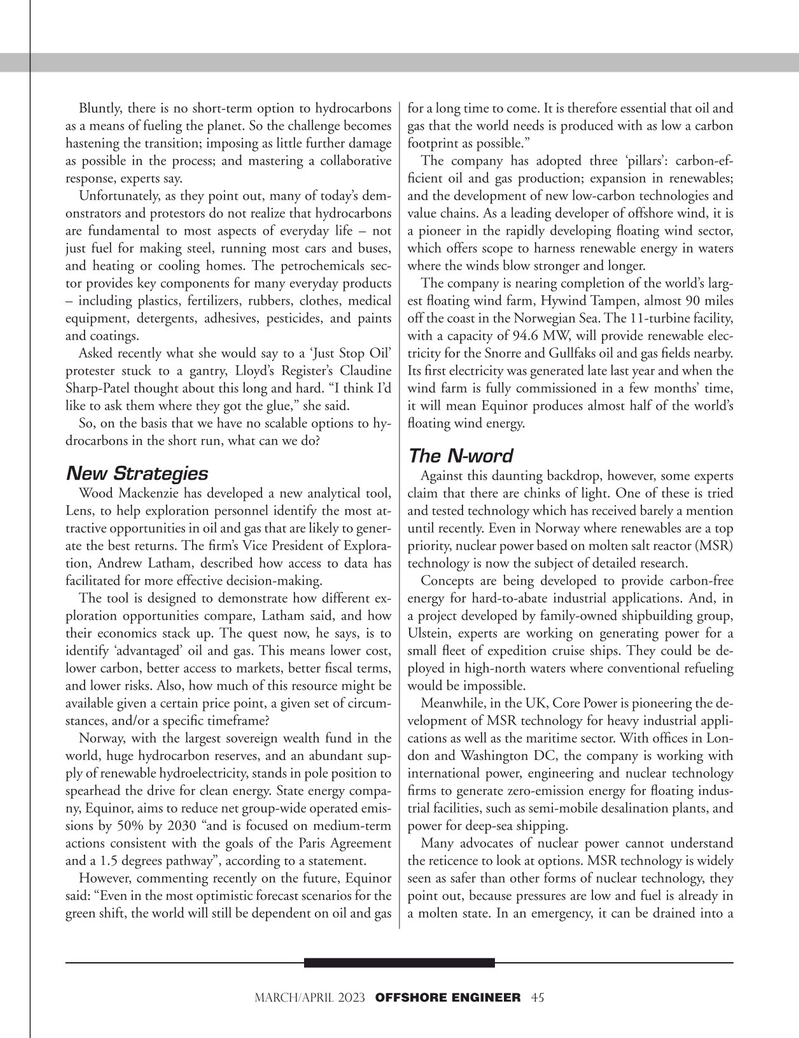
Page 45: of Offshore Engineer Magazine (Mar/Apr 2023)
Read this page in Pdf, Flash or Html5 edition of Mar/Apr 2023 Offshore Engineer Magazine
Bluntly, there is no short-term option to hydrocarbons for a long time to come. It is therefore essential that oil and as a means of fueling the planet. So the challenge becomes gas that the world needs is produced with as low a carbon hastening the transition; imposing as little further damage footprint as possible.” as possible in the process; and mastering a collaborative The company has adopted three ‘pillars’: carbon-ef- response, experts say. fcient oil and gas production; expansion in renewables;
Unfortunately, as they point out, many of today’s dem- and the development of new low-carbon technologies and onstrators and protestors do not realize that hydrocarbons value chains. As a leading developer of offshore wind, it is are fundamental to most aspects of everyday life – not a pioneer in the rapidly developing foating wind sector, just fuel for making steel, running most cars and buses, which offers scope to harness renewable energy in waters and heating or cooling homes. The petrochemicals sec- where the winds blow stronger and longer. tor provides key components for many everyday products The company is nearing completion of the world’s larg- – including plastics, fertilizers, rubbers, clothes, medical est foating wind farm, Hywind Tampen, almost 90 miles equipment, detergents, adhesives, pesticides, and paints off the coast in the Norwegian Sea. The 11-turbine facility, and coatings. with a capacity of 94.6 MW, will provide renewable elec-
Asked recently what she would say to a ‘Just Stop Oil’ tricity for the Snorre and Gullfaks oil and gas felds nearby. protester stuck to a gantry, Lloyd’s Register’s Claudine Its frst electricity was generated late last year and when the
Sharp-Patel thought about this long and hard. “I think I’d wind farm is fully commissioned in a few months’ time, like to ask them where they got the glue,” she said. it will mean Equinor produces almost half of the world’s
So, on the basis that we have no scalable options to hy- foating wind energy. drocarbons in the short run, what can we do?
The N-word
New Strategies
Against this daunting backdrop, however, some experts
Wood Mackenzie has developed a new analytical tool, claim that there are chinks of light. One of these is tried
Lens, to help exploration personnel identify the most at- and tested technology which has received barely a mention tractive opportunities in oil and gas that are likely to gener- until recently. Even in Norway where renewables are a top ate the best returns. The frm’s Vice President of Explora- priority, nuclear power based on molten salt reactor (MSR) tion, Andrew Latham, described how access to data has technology is now the subject of detailed research. facilitated for more effective decision-making. Concepts are being developed to provide carbon-free
The tool is designed to demonstrate how different ex- energy for hard-to-abate industrial applications. And, in ploration opportunities compare, Latham said, and how a project developed by family-owned shipbuilding group, their economics stack up. The quest now, he says, is to Ulstein, experts are working on generating power for a identify ‘advantaged’ oil and gas. This means lower cost, small feet of expedition cruise ships. They could be de- lower carbon, better access to markets, better fscal terms, ployed in high-north waters where conventional refueling and lower risks. Also, how much of this resource might be would be impossible. available given a certain price point, a given set of circum- Meanwhile, in the UK, Core Power is pioneering the de- stances, and/or a specifc timeframe? velopment of MSR technology for heavy industrial appli-
Norway, with the largest sovereign wealth fund in the cations as well as the maritime sector. With offces in Lon- world, huge hydrocarbon reserves, and an abundant sup- don and Washington DC, the company is working with ply of renewable hydroelectricity, stands in pole position to international power, engineering and nuclear technology spearhead the drive for clean energy. State energy compa- frms to generate zero-emission energy for foating indus- ny, Equinor, aims to reduce net group-wide operated emis- trial facilities, such as semi-mobile desalination plants, and sions by 50% by 2030 “and is focused on medium-term power for deep-sea shipping. actions consistent with the goals of the Paris Agreement Many advocates of nuclear power cannot understand and a 1.5 degrees pathway”, according to a statement. the reticence to look at options. MSR technology is widely
However, commenting recently on the future, Equinor seen as safer than other forms of nuclear technology, they said: “Even in the most optimistic forecast scenarios for the point out, because pressures are low and fuel is already in green shift, the world will still be dependent on oil and gas a molten state. In an emergency, it can be drained into a
MARCH/APRIL 2023 OFFSHORE ENGINEER 45

 44
44

 46
46